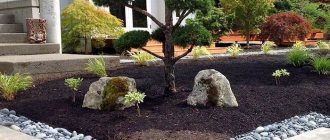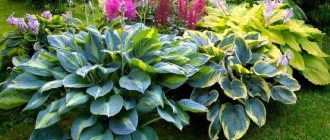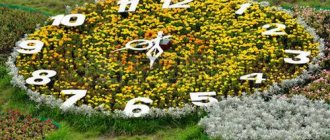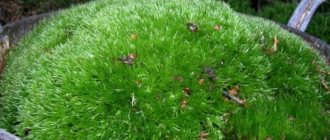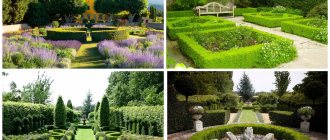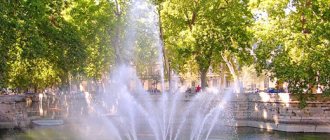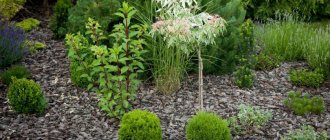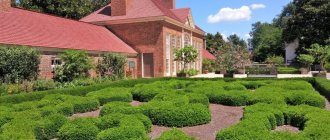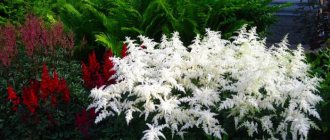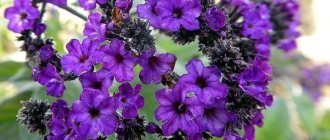Aster is a decorative flower, belongs to the genus of herbaceous plants (translated astrum - star). They belong to the Asteraceae (Asteraceae) family. There are both perennial and annual types of flowers. There are more than two hundred varieties.
When the aster blooms, the garden landscape is transformed beyond recognition
In the photo catalog you will see how asters are decorated and photos of flowers in the garden.
Asters in landscape design
Aster is a very bright and unpretentious flower. With this plant you can make a wonderful garden plot. All colors will open at the end of summer, beginning of September. It’s not for nothing that the aster is called the “Queen of Autumn.”
The varietal diversity of asters allows any gardener to create a beautiful flower garden in his or her summer cottage.
A flowerbed of asters always looks very laconic and will become an incredible decoration of any landscape. You can verify the diverse combination with the help of these photos of asters and different flowers in the flowerbed.
When designing a garden, you need to take into account the height of the flower. Plant length from 25 cm (dwarf) to 100 cm (giant).
Compact bushes with semi-double flowers are an excellent option for decorating a border in a garden bed.
You can plant aster in flower beds, alpine hills, ridges, and mixborders. The flower looks very advantageous in combination with natural stones of different sizes.
We present to your attention photos of asters in landscape design:
Look at the photo of the design of the area with asters in the garden:
Asters can be planted anywhere: in the middle of a flower bed, along a garden path or at the end of a vegetable bed.
It is better to plant dwarf asters along the contour of the flower bed, thereby making an accentuated transition to the main composition of plants. With this option, from the beginning of spring, flowers will decorate the flowerbed with thick greenery.
Flowerbeds with asters can be decorated using low-growing varieties. A low variety can be used as a bright spot inside a flower arrangement, or as a background aspect.
Tall asters with small flowers look good surrounded by low varieties with large buds
Tall asters can be used as an independent flowerbed bouquet or in a combination of long flowers.
Plants with which aster can be combined in design:
- Mordovik;
- fighter;
- oriental poppy;
- violet;
- geranium;
- bergenia.
In the photo there are asters with marigolds - all the colors of autumn in one flower bed
Agricultural technology or how to plant asters - two ways
Growing garden crops and flowers can occur in two ways - first planting seeds for seedlings, and then planting them in the ground in a greenhouse or outside. Or directly using the seedless method in flower beds and beds. But not all plants can be grown using two methods at once, because the climate in our country cannot be called favorable, unless in the regions of the south. But aster is also beautiful because the seedless method can be used not only in warm regions, but also in temperate zones. So, let us tell you about both methods, and you choose the best one for yourself.
For information! The seedling method involves sowing seeds to obtain seedlings at home or in greenhouse conditions. Seedless is when the crops are sown directly into the soil and no more replanting is required, maximum picking.
Popular perennial asters
Let's look at the most popular aster varieties. Today there are about 4,000 varieties. Perennial asters germinate well within 5–6 years.
Bushes of perennial asters need to be divided every 5–6 years
Flowers differ in height and flowering period, flower structure - peony-shaped, rose-shaped, chrysanthemum-shaped. The shape of asters is needle-shaped, spherical and radiant.
Garden aster (Chinese)
Callistephus (translated as beautiful wreath). Homeland - China.
Chinese aster may have round or slightly flattened inflorescences
The root system is located at a depth of 15-20 cm. The height of the plant is from 20-100 cm. The stems are green and rarely red, and have a bushy structure. The leaf blade is slightly lowered.
The bud is a basket of different size and colors, diameter 3-11 cm. The middle of the bud is often yellow. Garden aster of different colors, except orange and green.
Autumn New England aster (American)
Flowering occurs at the end of summer and continues until frost. With proper care and planting, the plant can reach a height of 150–200 cm.
American aster grows in slender bushes that do not require any support.
Inflorescences in the form of semi-double baskets are located on the top of tall shoots. Colors:
- pink;
- lilac;
- lilac;
- red;
- raspberry.
Dwarf alpine asters
Perennial. It has straight stems and small leaves. The inflorescence of the species is single and can reach from 3 to 8 centimeters in diameter, depending on the variety.
Dwarf asters are easy to care for and do not need to be tied up.
Height from 10-40 cm. Flower shades:
- dark purple;
- bright pink;
- dark purple;
- white;
- dark blue.
Summer sedum aster
This variety is native to Asia. The height of the plant reaches 80 cm. The variety is vulnerable to excess moisture and lack of heat and light.
The sedum-leaved aster blooms in early August with loose umbrellas with purple petals
The inflorescence bud is up to 2 cm in diameter, it has the shape of a basket, in the form of an umbrella.
Summer Italian asters
Flowering occurs from mid to late summer. Height is from 60 to 70 cm. Inflorescences in the form of corymbs reach 4 – 5 cm.
Italian asters prefer alkaline soils with good drainage.
Shades:
- dark blue;
- pink;
- lilac.
The shape of the bush is spherical. They love the sun and warmth.
Zinnia
One of the most popular varieties. There are a large variety of varieties. Height from 20–100 cm. Inflorescence diameter from 2–4 cm. Flower beds with zinnias will become a chic decoration for your garden.
Photo of a flower bed of zinnias:
Thanks to its unpretentiousness, zinnia is always a welcome guest in any suburban area.
Create a flower garden
When creating a flower garden, plant plants in groups: tall ones in the background, low ones in the foreground. I will offer two simple options for flower beds made from annuals.
First: in white and pink colors.
White, pink lavatera and pink cosmos in groups in the background of the flower garden. Closer - white and pink zinnias. Godetia and Drummond's phlox are spots in the foreground. And finally, line the edges of the flower bed with white allisum. You can add annual cornflower.
The second version of the flower garden: from annual flowers in red-orange color.
Scarlet amaranth in the background. Plus tall decorative sunflowers. Red and yellow zinnias. A group of annual dahlias. While the zinnias are growing, sow some eschscholzia between them. Asters in red and yellow shades. Some varietal calendula (be prepared, it will grow again next year). Use low-growing marigolds to line the edges of the flowerbed.
Planting in open ground
Planting in open ground should be done in moderately moist soil and in a sunny position. This is most often done in May, when the temperature during the day is 10-15 degrees.
Aster is planted either with seeds directly in open ground, or through seedlings that are grown at home from the last ten days of March
The flower loves illuminated areas - this must be taken into account when planting.
The soil must be prepared in advance for planting; it is advisable to add superphosphate.
In order for superphosphate to have time to “disperse” through the soil, it should be added during autumn digging.
Flowering period:
- early variety - flowering 90 days after germination;
- medium grade – 110 days;
- late variety – 130 days.
Make a bed, fill the bottom completely with compost, and you can additionally add complex fertilizer. After this, sift the seeds and sprinkle with soil.
In the prepared soil, use the edge of your palm to make grooves 1–3 cm deep
Seeds are sown in rows at a distance of 15-20 cm. You can sow more often, in case not everything germinates. Then you can simply thin out the crops.
Place compost at the bottom of the hole and cover with soil! Fertilizer cannot be placed directly under the roots!
In this case, you can plant both in spring and before winter.
There is no exact answer to when asters will bloom, it all depends on the variety. The dates are indicated on the packaging.
Rules for planting aster in open ground:
- Dig a hole no deeper than 2 cm.
- When the sprout is 4-5 cm, it needs to be transplanted, preferably in the evening and according to the lunar calendar.
- Create additional warmth in autumn and spring. Add potassium permanganate to boiling water and pour over the soil.
- Rarely water the soil with asters with warm water.
- Planting in the fall (around October) is done under sawdust or compost. In the spring, all that remains is to weed the beds around without touching the mulch (sawdust or compost).
- When planting in the spring, you need to take into account that the soil is sufficiently warm. The best time is late April and early May.
"Stars for the Newlywed"
If the bride's zodiac sign is Virgo, then a bouquet of asters, which are symbolic for her, will be perfect for her. They are also suitable for Taurus, Gemini, Leo and Libra girls.
Let's make a round bouquet for the bride with our own hands, you will need:
- large-headed orange asters 3-5 pcs.;
- bright orange roses 3-5 pcs.;
- milky cream roses 3-5 pcs.;
- cream or white carnations 3-5 pcs.;
- branches of red hyrepicum berries 2 pcs.;
- branches of green skimia berries 2-3 pcs.;
- bright orange satin ribbon;
- milky white satin ribbon;
- porta bouquet holder;
- PR flor floral sponge;
- pruner;
- double sided tape;
- scissors.
We arrange a beautiful bouquet of asters for the bride:
- Cut off the long stems of the roses and place them on top of double-sided tape. This “fence” will be needed to decorate the lower part of the porta bouquet’s leg, to imitate a bouquet on its stems.
- From a piece of PR flora we cut a ball the size of the middle of the porta bouquet and place it in a container with a nutrient solution for cut flowers. It takes several hours for the sponge to saturate properly. When the ball sinks to the bottom of the container, then you can begin assembling the bouquet.
- We install the porta bouquet with a row of legs attached in a tall narrow container. In order not to touch the elements with your hands several times during assembly. Decorate the outer edge with rose leaves. We begin the assembly by installing the roses.
- We stick all the flowers from the sponge in a circle, trying to keep different elements nearby.
- We complement the bouquet with branches of decorative berries in red and green tones.
- We wrap the lower part with the stems with bright orange ribbon. We tie a bow from a milky or cream colored ribbon on top.
- If it is possible to make a pendant with a photograph of the newlyweds, this will add an unusual and unique composition to the bride.
Caring for asters
An important step in growing all varieties of aster is feeding. Throughout the entire season, you need to fertilize the soil at least three times:
- 10 days after planting.
- When the first bud appears.
- At the beginning of flowering.
The fertilizer can be used dry, sprinkled near the roots, or the fertilizer can be dissolved in water!
For feeding use:
- ash;
- potassium sulfate;
- ammonium nitrate;
- superphosphate.
Aster does not tolerate excess moisture, but only in very hot and dry weather do they need to be watered abundantly.
In dry weather, asters are watered 1–2 times a week
Weeds must be removed periodically. They prevent abundant growth and flowering.
Photos of flower beds from asters:
To prevent flower diseases, you can use nettle infusion:
- 1 kg of nettle – 1 bucket of boiling water;
- stand for several days;
- add 1 cup of solution to 1 bucket of water.
Nettle infusion contains nitrogen, silicon and other useful microelements.
If the soil was mulched during planting, frequent watering is not necessary. You just have to loosen the soil superficially. If there is no mulch, then water when the soil dries out with the addition of mineral fertilizers.
If a sufficient amount of fertilizer was added to the hole when planting, then it is not necessary to produce additional feeding.
Autumn anniversary
Homemade pink asters are perfect for making a DIY gift bouquet for the anniversary of a mature woman. To do this you need:
- 35-45 asters of the same color, variety and size;
- green tape;
- white decorative satin ribbon;
- scissors or pruning shears.
Step-by-step design of a composition of asters in the form of a Biedermeier ball, following all the steps:
- We clear the stems of asters from the bottom of the foliage, so it will be more convenient to work with them and cut them at an angle of 45 degrees.
- Assembling the bouquet starts from the middle. We choose the longest and hardest stems. We lay a dense second row around the first central aster. Wrap with adhesive tape.
- A little lower in relation to the first row we apply the second and subsequent rows. Gradually forming a spherical shape.
- We tie the lower part of the stems with several layers of tape, over which we wrap a white satin ribbon. We tie a neat bow.
- Trim the stems to the same level and remove excess stray leaves.
A bouquet with spikelets, butterflies or rowan clusters looks beautiful, but even without additional decor it looks very elegant and expensive.
What flowers can you plant an aster with?
Dahlias, chrysanthemums, echinacea, and iris can be perfectly placed in the same flower bed with asters. Low-growing asters are combined with carnations and marigolds. Tall ones can be combined with ornamental grasses and yarrow.
The photo shows a flower garden with bush aster, heucheras and ornamental grasses
Neighborhood preventing fusarium:
- petunias;
- nasturtiums;
- phlox (if they were predecessors in the flowerbed).
Asters of medium height can be combined with yarrows and ornamental grasses.
Do not plant roses next to the aster, they take away your vitality!
Astra has long won the hearts of gardeners with its unpretentiousness and the hearts of beauty lovers with its indescribable beauty.
Hedgehog for baby
Flower bouquets in the form of animal figures are a nice gift for kids. To make “Hedgehog” you will need:
- yellow small asters or chrysanthemums 2-3 branches;
- small-flowered white chrysanthemum 1-2 branches;
- fern leaves 10 pcs.;
- floral sponge “oasis”;
- white cardboard or other stand;
- toothpicks;
- black berries for eyes and nose.
Making a beautiful bouquet in the shape of a toy for a child:
- From a floral sponge we cut out an elongated shape for the body of a hedgehog. We saturate it with a nutrient solution for flowers.
- We pick off the inflorescences of asters and chrysanthemums and form a toy by sticking them into a sponge.
- We spread the fern leaves on the cardboard, placing the tops apart from each other. Place a hedgehog figurine on top.
- We break a toothpick in half and stick berries on it for the nose and eyes. We insert a toothpick into a sponge. For naturalness, you can use eyes that are sold in a craft store.
Photo of asters in the garden
Features of cultivation
If you want to see well-developed and beautiful flowers on your site, you should take care of how to grow them correctly. They are quite simple, and following them will not take much time and will not require much effort from you.
To begin with, you need to choose a suitable location. These are well-lit, sunny places that are protected from drafts and sharp gusts of wind. The soil in such areas should be well-drained, and the best option would be sandstone or loam, light and breathable, with a distant groundwater level. The acidity of the soil should also be appropriate and remain at 6.5-7.5 pH. It would be quite correct to plant asters in places where perennial herbs, marigolds, and calendula were previously grown, but you should refrain from planting flowers in areas where carnations, gladioli or tulips were previously grown.
Of course, it is most correct to grow asters at a temperature of about +15°C and at a humidity of 70%, but if this is not possible, then simply try to ensure proper soil moisture. Excessive watering is not necessary here at all, but if the summer is hot and dry, then try not to leave the plants without moisture at all, this can kill them, despite the fact that this is a fairly drought-resistant crop. In particular, proper and systematic watering is necessary during the budding period. This way you will ensure beautiful and abundant flowering.
Herbal decoctions
This method of fighting aphids is one of the most common.
Herbal decoctions have insecticidal, fungicidal and antifeedant properties and are very effective in controlling insect pests. Here are the plants that are most often used to prepare decoctions, and popular recipes for herbal decoctions against aphids:
- Tobacco
Leave 200 g of crushed dry leaves in 5 liters of water for 24 hours. Then bring to 10 liters and simmer over low heat for 1.5-2 hours.
- Tomato tops
Pour 5 kg of green leaves and shoots into 10 liters of hot water and boil for 30 minutes. over low heat. Spray in a concentration of 1:3 (3 liters of water per 1 liter of decoction). Before spraying, add 30 g of soap per 10 liters of water.
- Yarrow
Keep 1 kg of dry common grass (collected at the beginning of flowering) in a water bath for 30-40 minutes. in 2 liters of water. Bring the volume of the decoction to 10 liters and keep in a dark place for at least 2 days.
- Hot pepper
Boil 100 g of fresh pods for at least an hour in 1 liter of water in a sealed container. Leave for 2 days, grind the pepper, strain the solution. For spraying, dilute the concentrate 1:10, add 40 g of soap per 10 liters of solution.
- Celandine
Chop 400 g of fresh stems and flowers (or 100 g of dried ones), add 1 liter of water and leave for 1-1.5 days, then boil for 20-30 minutes.
You can find a large assortment of biological products to combat aphids in our catalog, which combines offers from various gardening online stores. .
Basil repels aphids
The enemy of aphids is the ladybug
To lure hoverflies to the site, it is recommended to plant. Hoverflies do not destroy aphids; they feed on daisy pollen. But the larvae of hoverflies consume large quantities of aphids that are nearby. Therefore, you can’t go wrong by inviting hoverflies to your dacha.
Ground beetles will choose nightshades and lacewings, while the lacewing will prefer cool, shady places covered with fern thickets for breeding.
You can place flower pots with wood shavings in the garden - earwigs, who are also not averse to eating aphids, can live in them.
In addition, the larvae of ladybirds and lacewings can be purchased at specialized garden centers (or ordered by mail), and then released on your site.
Birds
What is especially pleasing is that aphids are a prey item for many small birds. They feed it to their chicks. They readily eat aphids:
- sparrows;
- Chiffchaffs;
- willow warblers;
- tits;
- kings;
- wrens;
- Robins;
- linnets.
To attract these little birds, you can hang birdhouses (and) in your summer cottage, place containers with water - in a word, make the birds want to fly here.
But! If you have already decided to attract beneficial insects and birds to help, you will have to completely abandon the use of pesticides on your site!
Birds willingly feed on aphids
Indoor flowers are a source of pride for any housewife. They bring comfort to any home, give the interior completeness and add color. It is not surprising that such a phenomenon as aphids on indoor plants saddens any housewife.
Aphids are a terribly unpleasant insect that can ruin not only the appearance of a plant, but also lead to its death. Aphids spread at a rapid pace, so it is important to begin the fight against these pests in a timely manner.
Most of these pests do not exceed 2-3 mm in size, although there are varieties up to 7 mm. Aphids vary in color: aphids are known to be white, yellow, pink, green and even black.
Each colony contains wingless and winged aphids. Winged ones are responsible for distribution, and winged ones provide reproduction.
It is known that if there is sufficient food, only wingless aphids appear on flowers, ensuring rapid reproduction. One female is capable of giving birth to three generations of offspring numbering up to 100 thousand individuals in a month.
Aphids are equipped with a special proboscis that allows them to pierce plants and suck out all the juices from them. As they suck out the juices, aphids secrete a sweet liquid, or honeydew, a delicacy that attracts other insects, especially ants.
There are often cases when ants create their own “troops” of aphids for food, protect them, transfer them to new plants, and even take them into their homes for the winter if necessary.
Aphids concentrate on young stems and the undersides of leaves. Injured leaves curl and become deformed, the buds of damaged plants fall off without opening.
Honeydew leads to the development of sooty fungus. This disease slows down the respiration process of flowers and can lead to death.
As a rule, aphids settle on plants in entire colonies, so you can see them on plants with the naked eye. To minimize the risk of encountering these pests, you need to know how they enter your apartment.
Why are aphids dangerous?
Leaf aphids quickly weaken young plants by sucking out their cell sap.
At the same time, it also secretes poison, due to which the leaves curl, deform and die, the shoots stop growing, and the tops become bent. Sweet secretions (natural waste) contaminate the leaf surface and disrupt the normal functioning of plants. Through their saliva, aphids are capable of infecting plants with harmful viruses, which can cause widespread damage, especially in gardens or professional rose gardens. When aphid colonies become too large, the leaves and young shoots dry out and die.
Aphids cause the greatest damage to young fruit trees.
Aphids can produce up to 50 generations per summer
If you do not use any special techniques against this pest, the aphid will cause significant damage to any, even the most well-groomed summer cottage, in a completely natural way, without straining, producing up to fifty generations over the summer. It is not without reason that in the northern hemisphere alone, about 450 species of leaf aphids are considered among the most important in agriculture, forestry and horticulture.
Aphids need to be fought
It is extremely difficult to fight aphids: they multiply rapidly and incessantly. Therefore, we must try to get rid of it faster than it will rid us of the harvest.
Diseases and pests
Experts say that no matter how strong asters may seem, in fact, they are susceptible to many diseases. And, first of all, this is root rot . Timely prevention can save you from the disease by spraying the bushes with a solution of sulfuric acid salts with magnesium, copper and zinc.
Powdery mildew is also common , and most often visits plants growing in poor soils. The disease can ruin the decorative appearance of flowers even if the plants are not rejuvenated in a timely manner or if watering is improper. To treat powdery mildew, plants are sprayed with sulfur preparations.
Late blight is the next disease that definitely needs to be mentioned. You can avoid it by keeping your plantings clean. You can also prevent the disease by spraying with copper preparations.
As you can see, there are many diseases, and each of them can not only harm the plants that you like so much, but even destroy them. Therefore, you should be very careful and often pay attention to the appearance of asters in order to notice negative changes in time and take active action. But attentiveness is useful not only in case of diseases, because a lot of pests also hunt for beautiful and fragrant flowers. The most important of them are considered to be cutworm butterflies, whose caterpillars seriously eat the greenery of the plant. To prevent this, you should promptly remove old plants from the garden bed, try to pull out weeds in a timely manner, and loosen the soil. By the way, these actions will not allow attacks by bud aphids, which should further encourage summer residents to keep their plantings clean. Do not forget to also carry out preventive spraying of plants with karbofos, phosphamide and chlorophos, which will help to quickly get rid of unwanted insects if they have already begun their activity on the foliage.
They attack aster and other pests, which cause no less harm. These are slugs and spider mites. Sprinkling with lime and superphosphate, as well as deep loosening of the soil, will help get rid of the former. The best way to get rid of ticks is by spraying with infusions of garlic or onion.
How to care?
The main care for asters consists of periodically loosening the soil. The main thing is to prevent excessive compaction and the formation of a soil crust. At the same time, we remove weeds between the rows and near the bushes. Water the plants as needed. Perennial asters experience the greatest need for watering during dry periods and during increased growth of vegetative mass. Plants are responsive to the application of phosphorus fertilizers and lime, as well as feeding with special mineral complexes during the growing season.
Description of the species
Alpine aster belongs to the category of perennial asteraceous ground cover plants and resembles a small shrub. The height of perennial varieties reaches up to 30 cm. The size of the bush directly depends on the level of sunlight: the more natural sunlight the plant receives, the more magnificent the bush grows.
Due to the fact that the root system is thick, superficial and grows horizontally, the herbaceous plant can take root even in a mountainous or rocky place. Each root shoot turns into a strong stem with many formed dark green leaves.
The shape of the flowers is similar to a daisy with a diameter of no more than 5 cm. The petals are located in several rows around the yellow core. Lush inflorescences can be lilac, pink, purple or white.
The aster flowering period lasts from late May to late July-early August. Subsequently, the buds turn into a cup filled with seeds with small hairs at the ends. It is these hairs that help the seeds fly as far as possible for self-sowing.
